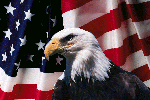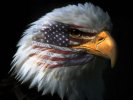

The Bald Eagle & Official State Birds
The Eagle became the National emblem in 1782 when the great
seal of the United States was adopted. The Great Seal shows a
wide-spread eagle, faced front, having on his breast a shield
with thirteen perpendicular red and white stripes, surmounted by
a blue field with the same number of stars. In his right talon
the eagle holds an olive branch, in his left a bundle of thirteen
arrows, and in his beak he carries a scroll inscribed with the
motto: "E Pluribus Unum." The Eagle appears in the Seals of many
of our States, on most of our gold and silver coinage, and is
used a great deal for decorative patriotic purposes.
The Bald Eagle was chosen June 20, 1782 as the emblem of the
United States of American, because of its long life, great strength
and majestic looks, and also because it was then believed to exist
only on this continent.
In 1982 President Ronald Reagan, proclaimed June 20, 1982 as
National Bald Eagle Day and designated the year 1982 as the
Bicentennial Year of the American Bald Eagle. President Reagan called
upon the people of the United States to join in these observances
with appropriate activities in their homes and communities.

About Bald Eagles:
Male bald eagles generally measure 3 feet from head to tail,
weigh 7 to 10 pounds, and have a wingspan of about 6 1/2 feet.
Females are larger, some reaching 14 pounds and having a wingspan
of up to 8 feet.This striking raptor has large, pale eyes; a
powerful yellow beak; and great, black talons. The distinctive
white head and tail feathers appear only after the bird is 4 to 5 years old.
Bald eagles are believed to live 30 years or longer in the wild,
and even longer in captivity. They mate for life and build huge
nests in the tops of large trees near rivers, lakes, marshes, or
other wetland areas. Nests are often re-used year after year.
With additions to the nests made annually, some may reach 10 feet
across and weigh as much as 2,000 pounds. Although bald eagles
may range over great distances, they usually return to nest
within 100 miles of where they were raised.
Bald eagles normally lay two to three eggs once a year and the
eggs hatch after about 35 days. The young eagles are flying
within 3 months and are on their own about a month later.
However, disease, lack of food, bad weather, or human
interference can kill many eaglets; sometimes only about half
will survive their first year.
The staple of most bald eagle diets is fish, but they will feed
on almost anything they can catch, including ducks, rodents,
snakes, and carrion. In winter, northern birds migrate south and
gather in large numbers near open water areas where fish or other
prey are plentiful.
Wildlife experts believe there may have been 25,000 to as many as
75,000 nesting bald eagles in the lower 48 states when the bird
was adopted as our national symbol in 1782. Since that time, the
bald eagle has suffered from habitat destruction and degradation,
illegal shooting, and contamination of its food source, most
notably due to the pesticide DDT. By the early 1960s there were
fewer than 450 bald eagle nesting pairs in the lower 48 states.
Bald eagles have few natural enemies. But in general they need an
environment of quiet isolation; tall, mature trees; and clean
waters. Those conditions have changed over much of the bald
eagle's former habitat.
Official State Birds
Alabama - Yellowhammer
Alaska - Willow ptarmigan
Arizona - Cactus wren
Arkansas - Mockingbird
California - California valley quail
Colorado - Prairie Lark-Finch
Connecticut - Robin
Delaware - Blue hen chicken
Florida - Mockingbird
Georgia - Brown thrasher
Hawaii - Nene
Idaho - Mountain Bluebird
Illinois - Northern Cardinal
Iowa - Eastern Goldfinch
Indiana - Cardinal
Kansas - Western Meadowlark
Kentucky - Cardinal
Louisiana - Brown pelican
Maine - Chickadee
Maryland - Baltimore Oriole
Massachusetts - Chickadee
Michigan - Robin
Minnesota - Common Loon
Mississippi - Mockingbird
Missouri - Bluebird
Montana - Western Meadowlark
Nebraska - Western Meadowlark
Nevada - Mountain Bluebird
New Hampshire - Purple Finch
New Jersey - Eastern Goldfinch
New Mexico - Roadrunner
New York - Bluebird
North Carolina - Cardinal
North Dakota - Western Meadowlark
Ohio - Cardinal
Oklahoma - Scissor-tailed Flycatcher
Oregon - Western Meadowlark
Pennsylvania - Ruffed Grouse
Rhode Island - Rhode Island Red
South Carolina - Great Carolina Wren
South Dakota - Ring-necked Pheasant
Tennessee - Mockingbird
Texas - Mockingbird
Utah - Sea gull
Vermont - Hermit Thrush
Virginia - Cardinal
Washington - Willow Goldfinch
West Virginia - Cardinal
Wisconsin - Robin
Wyoming - Western Meadowlark
Official Birds of CanadaCanada's national bird is the Common Loon.
The bird symbols of Canada's provinces and territories are:
Alberta - Great Horned Owl
British Columbia - Steller's Jay
Manitoba - Great Gray Owl
New Brunswick - Black-capped Chickadee
Newfoundland - Atlantic Puffin
Northwest Territories - Gyrfalcon
Nova Scotia - Osprey
Nunavut - none yet
Ontario - Common Loon
Prince Edward Island - Blue Jay
Quebec - Snowy Owl
Saskatchewan - Sharp-tailed Grouse
Yukon - Common Raven
Back to Bird Fun Stuff
For Cool & Fun Info on all aspects of pet care and other interesting stuff:
Get Your FREE Subscription to:
Tippy & Alfred's Newsletter.....
"The Peppy Pets"
Pet Care Tips Directory
Gift Items for All Pet Lovers
Canine Care Tips
Feline Care Tips
Horse Care Tips
Home
Site Map
Copyright ©
Choose To Prosper